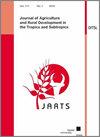马达加斯加农业生态实践对土壤有机碳固存的影响——采用共时和历时方法
Q3 Social Sciences
Journal of Agriculture and Rural Development in the Tropics and Subtropics
Pub Date : 2020-06-16
DOI:10.17170/KOBRA-202005281299
引用次数: 2
摘要
农业系统中的土壤有机碳固存是全球范围内提高土壤肥力和缓解气候变化的关键指标。在马达加斯加,从传统做法转变为农业生态做法对有机碳封存的影响尚不清楚。本研究的目的是:(i)评估农业生态实践,如农林业(AF)、植树造林(TP)和改良农业实践(IFP),对田间SOC固存的影响;以及(ii)在采用农业生态实践后,使用共时和历时方法来量化SOC封存。对于历时方法,使用两个采样年(2014年和2018年)来评估农业生态实践的年度土壤固碳率。对于同步方法,将农业生态实践产生的SOC封存与参考田上的SOC封存进行了比较,如休耕地(FL)和传统农业实践(TFP)。对36块具有农业生态实践的田地和60块参考TFP和FL田地进行了土壤取样。历时法表明,AF、TP和IFP的SOC固存率分别为+2.8、+1.6和-0.9 MgC.ha-1.yr-1。同步方法表明,AF中的SOC存量(109.4 MgC.ha-1)高于参考TFP(73.8 MgC.ha-1)和FL(67.4 MgC.ha-1)田。IFP(74.8 MgC.ha-1)和TP(69 MgC.ha-1)的SOC存量与参考田相比没有显著差异。当采用农业生态实践代替传统实践时,这项研究更好地了解了马达加斯加农场层面的土壤碳动态。本文章由计算机程序翻译,如有差异,请以英文原文为准。
Impact of agroecological practices on soil organic carbon sequestration using synchronic and diachronic approaches in Madagascar
Soil organic carbon (SOC) sequestration in agricultural systems is a key indicator of soil fertility improvement and climate change mitigation at the global scale. In Madagascar, the effect on SOC sequestration of converting from traditional practices to agroecological ones remains unclear. The objectives of this study were (i) to assess the impact of agroecological practices, such as agroforestry (AF), tree plantation (TP) and improved farming practices (IFPs), on SOC sequestration at the field level; and (ii) to use both synchronic and diachronic approaches to quantify SOC sequestration following the adoption of agroecological practices. For the diachronic approach, two sampling years (2014 and 2018) were used to assess the annual soil carbon sequestration rates with agroecological practices. For the synchronic approach, SOC sequestration arising from agroecological practices was compared to that on reference fields, such as fallow land (FL) and traditional farming practices (TFPs). Soil sampling were carried out on 36 fields with agroecological practices and 60 reference TFP and FL fields. The diachronic approach showed that SOC sequestration rates for AF, TP and IFPs were respectively, +2.8, +1.6 and -0.9 MgC.ha -1 .yr -1 . The synchronic approach showed that SOC stock in AF was higher (109.4 MgC.ha -1 ) than in reference TFP (73.8 MgC.ha -1 ) and FL (67.4 MgC.ha -1 ) fields. The SOC stock in IFP (74.8 MgC.ha -1 ) and TP (69 MgC.ha -1 ) presented no significant difference compared to reference fields. This study provided a better understanding of soil carbon dynamics at the farm level in Madagascar when agroecological practices are adopted in place of traditional practices.
求助全文
通过发布文献求助,成功后即可免费获取论文全文。
去求助
来源期刊
CiteScore
2.30
自引率
0.00%
发文量
0
审稿时长
>36 weeks
期刊介绍:
The Journal of Agriculture and Rural Development in the Tropics and Subtropics publishes papers dealing with original research and review papers in the fields of plant production, animal nutrition and animal husbandry, soil science, rural economy and farm management, forestry and forest economy, veterinary hygiene and protection against epidemics.

 求助内容:
求助内容: 应助结果提醒方式:
应助结果提醒方式:


